After what was one of the most inspiring starts to a La Liga campaign, Sevilla fell off drastically and are still in search of better times. Their visits to other teams have left them with little points to talk about but Ramon Sanchez Pizjuan has always been their fortress. It’s been the place where giants come to fall and none of the ordinary laws of football apply.
Sure, it sounds romanticised, and in its essence it really is, but considering that they have lost only one game at home in the last 16 fixtures tells a lot. Of course, this doesn’t include their latest bout with Barcelona because apparently no ordinary or extraordinary laws apply to otherworldly beings. When facing Blaugrana, you clearly face those.
This tactical analysis will use statistics to determine how Barcelona came from behind twice to snatch a La Liga victory from Sevilla in what was an exciting performance from both sides.
Lineups
Barcelona (4-3-3)
Starting XI: ter Stegen – Semedo, Pique, Umtiti, Alba – Rakitić, Busquets, Vidal – Messi, Suarez, Coutinho
Bench: Iñaki Peña, Lenglet, Murillo, Aleñá, Sergi, Malcom, Dembélé
Coach: Ernesto Valverde
Sevilla (3-4-2-1)
Starting XI: Vaclik – Mercado, Kjaer, Gómez – Navas, Rog, Banega, Sarabia, Wöber – Ben Yedder, Promes
Bench: Soriano, Arana, Vázquez, Amadou, Roque Mesa, Silva, Munir
Coach: Pablo Machin
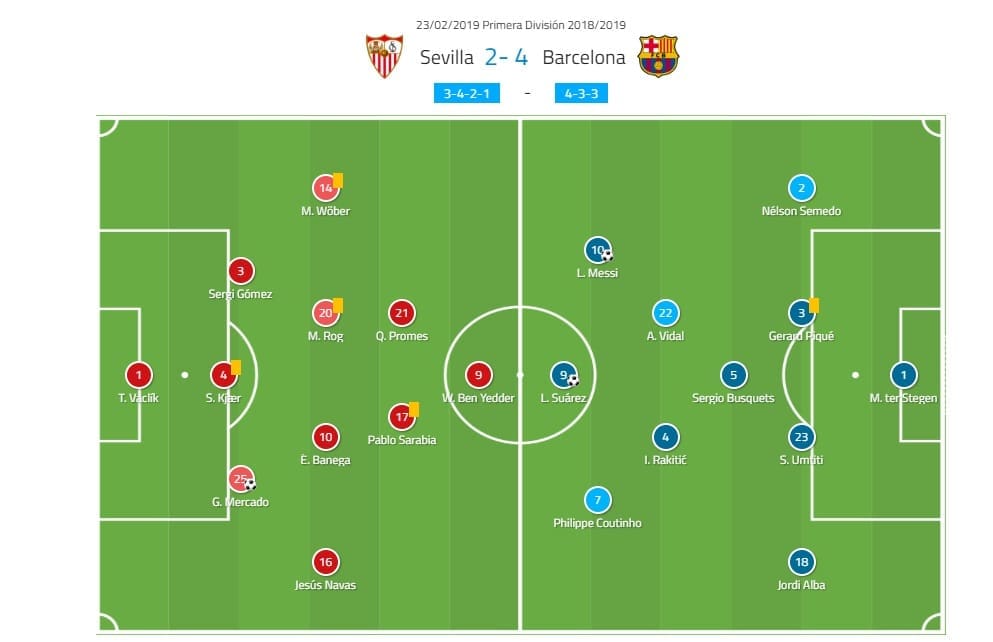

Barcelona setup
Catalan legs are getting wearier with each passing day but even with knowing that, Ernesto Valverde does not like to gamble much when it comes to La Liga. The Ant fielded what seemed to be a formation fairly close to his first-choice XI, with some exceptions.
Samuel Umtiti was finally back in action after having missed three months of football. Although the Frenchman featured on the bench in the Champions League clash against Lyon, this time he got his spot right from the start due to Clement Lenglet being sick with fever the night before.
Nelson Semedo was also picked in front of Sergi Roberto, and Philippe Coutinho was surprisingly chosen instead of Ousmane Dembele, regardless of the Brazilian’s obvious dip in form as of late.
The rest of the squad was as expected, especially considering the tough fixture ahead. Barcelona played in a 4-3-3 system but switched to 4-2-3-1/ 4-4-2 in the second half when things were not looking as good with the initial formation.
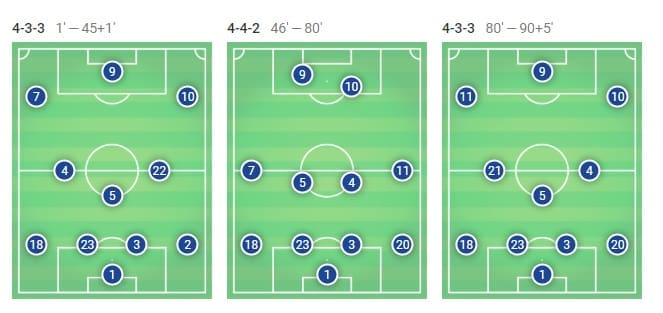
Sevilla setup
Pablo Machin also decided to field a strong team in front of his fans so he didn’t shuffle his deck too much. The back line, therefore, remained untouched as Tomas Vaclik was between the sticks, and guarded by a back three of Sergi Gomez, Simon Kjaer and Gabriel Mercado.
Some changes, however, were made in midfield. Maximilian Wober played on the left, followed by Ever Banega and a newcomer to the team, Marko Rog, in the middle, with Jesus Navas on the right. Pablo Sarabia was given a more offensive role, just behind the attacking duo up front.
Speaking of the offensive outlets, Machin decided to go with Quincy Promes as Wissam Ben Yedder’s partner in crime, leaving Andre Silva, who started in the victory against Lazio in the Europa League, on the bench.
The Andalusians were deployed in an interesting 3-4-2-1 formation but swapped to a more compact version in 3-5-2 or 5-4-1 in defence when soaking up pressure and setting up the counters.
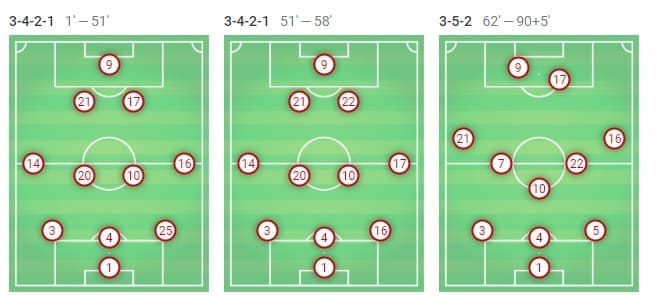
Sevilla’s resurgence
Many predicted that this would be a low-scoring type of game due to both teams experiencing a drought in front of goal as of late. Sevilla have managed only two in their last three games, and Barcelona, surprisingly, only three in their last three. But if experience has taught us anything, it’s that these teams tend to score against each other. A lot.
This game was no exception and, as expected, it was one of great intensity and even better football. The Andalusians took the upper hand at the very beginning, which was mostly predicted prior to the match. Coming to Ramon Sanchez Pizjuan and expecting to dominate Sevilla is a fool’s errand, and the Catalan felt it on their skin.
Machin was left without Sergio Escudero for the big clash since the Spaniard is out with an injury. On the left was, therefore, the young Austrian former Ajax and Rapid Vienna defender Maximilian Wober. He had been dubbed a great talent that fell off at the moment he was supposed to reach for the sky.
Although Wober is a great defensive aspect of Sevilla’s game, we knew he wouldn’t offer the same offensive outlet as his Spanish counterpart. Still, the Andalusians preferred to attack through the left with a big majority (45%) of their efforts distributed through that flank.
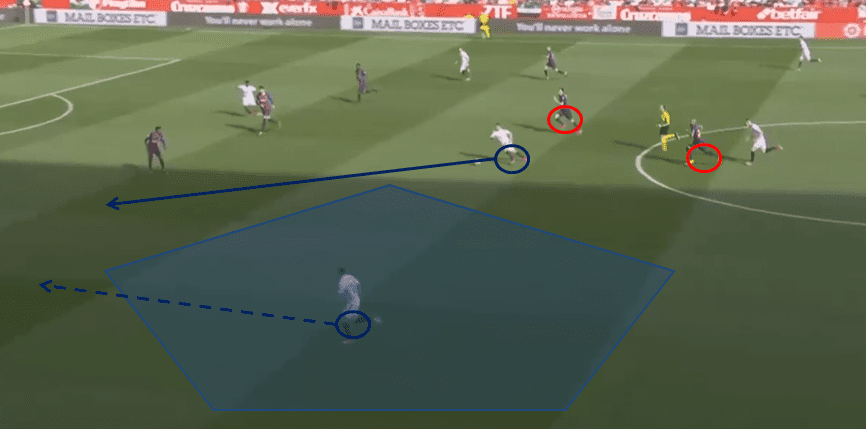
The image above shows exactly why, and Ernesto Valverde’ personnel choice played right into their hands. Lionel Messi, Nelson Semedo, and Arturo Vidal occupied the right side of the pitch for Barcelona but in transitions, which the Catalans are extremely slow at, it was only up to the Portuguese right-back to stop the bleeding.
Notice how Messi stopped somewhere just above the middle of the park, while Arturo Vidal struggles to keep up with the sprinting Sevilla men. As a result, and with no usual cover for that side in the form of either Sergi Roberto or Ivan Rakitić, Barcelona were exposed and conceded the first chance of the game barely a couple of minutes in.
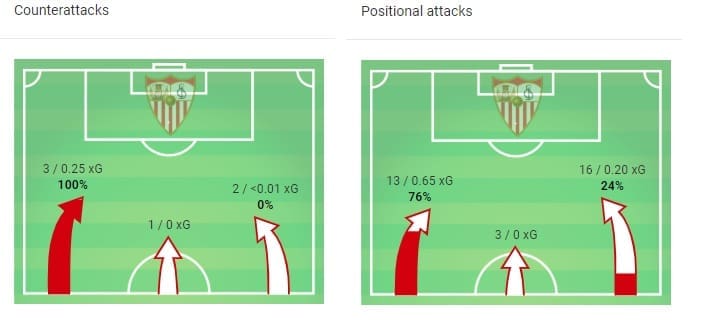
Barcelona did manage to maintain their possession dominance in most parts of the game but they were not proactive enough. A lot of that was due to the wrong approach by the Blaugrana and Ernesto Valverde. With Coutinho and Messi on the wings, the Catalans lost all of their width, which they are almost always lacking, and instead, concentrated their efforts into the middle.
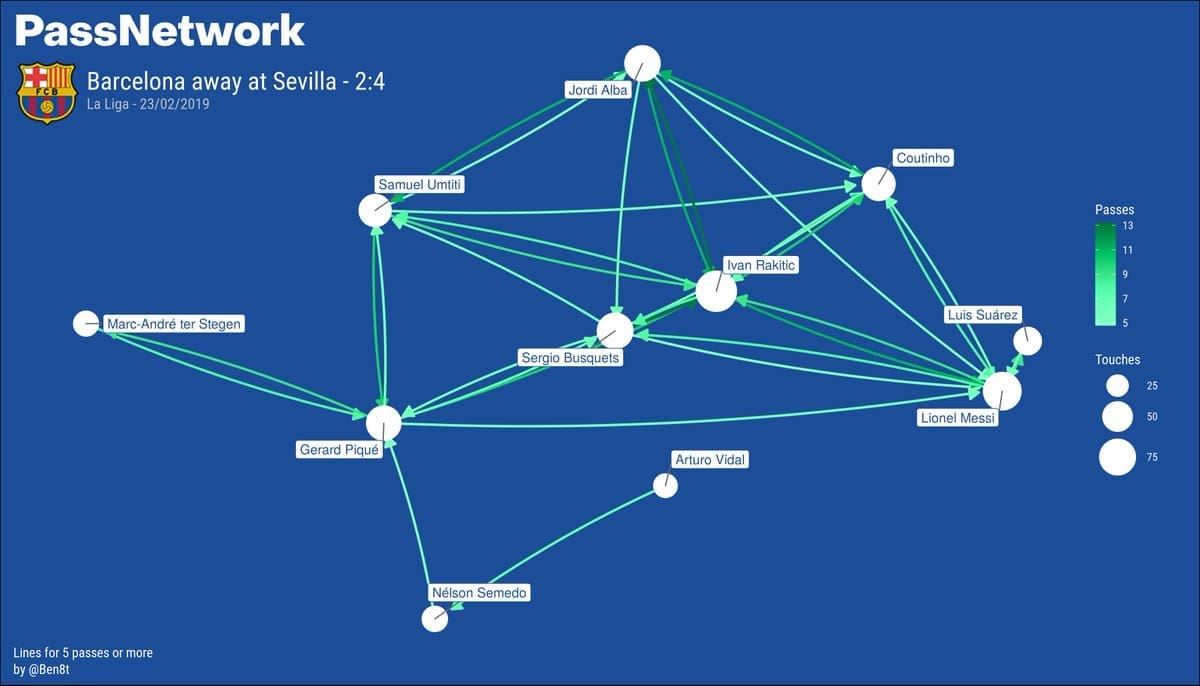
That was exactly what Sevilla wanted with their extremely narrow and compact low block when welcoming Barcelona into their own half. Notice in the image below how Machin’s troops are organised.
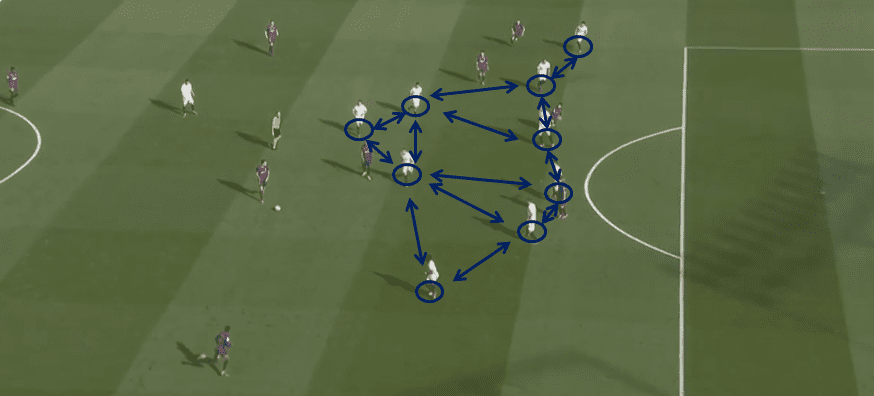
There are a couple of key points that need to be noticed here. Firstly, the short distance between all of Sevilla’s defending players ensures a couple of things. A high number of connections makes it extremely difficult to disrupt and pierce the shape. If the penetration does occur, there are always players ready to pounce and cover for their teammate.
This compact system also offers a lot of access to the ball. This in turn also means that there are more players who can pressurise the ball-carrier at any given point in time, as well as limit opposition passing channels. It makes it nigh on impossible to dribble through, even if you are Lionel Messi, which says a lot.
The last thing but nowhere near the least valuable is the spatial control, which was why Sevilla opted for such a structure, in the first place. By being this compact and narrow, Sevilla forced Barcelona to either go down the wings and rely on crosses, which they are pretty bad at taking advantage of (their average success rate is 30.1%), or try the suicide mission of going through the middle.
Surprisingly enough, the Catalans opted for the latter option, failing at it time and time again. Their success, at least in the first 45 minutes of the game, depended on some Messi magic, but that is not really anything new, is it now?
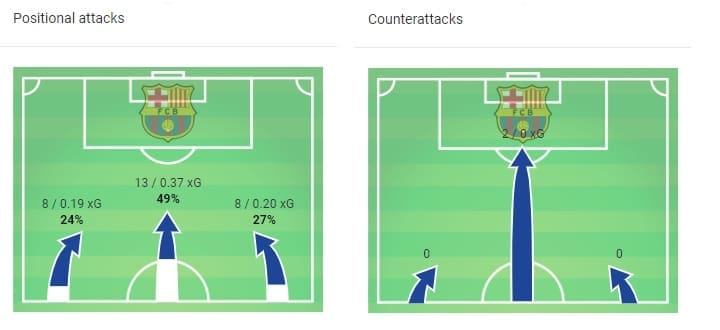
With all of that being said, Sevilla did not sit back and rely solely on counter-attacks in the first half. They were the more dangerous team, both from quick transitions and positional play. The key aspect was not letting Barcelona play out of the back, which worked wonders.
The biggest proof of that lies with the Catalans’ goalkeeper, Marc-Andre ter Stegen, who is known for his pinpoint accuracy and the skill to shake off pressure. In this game, he was put to the test, and limited in passing options.
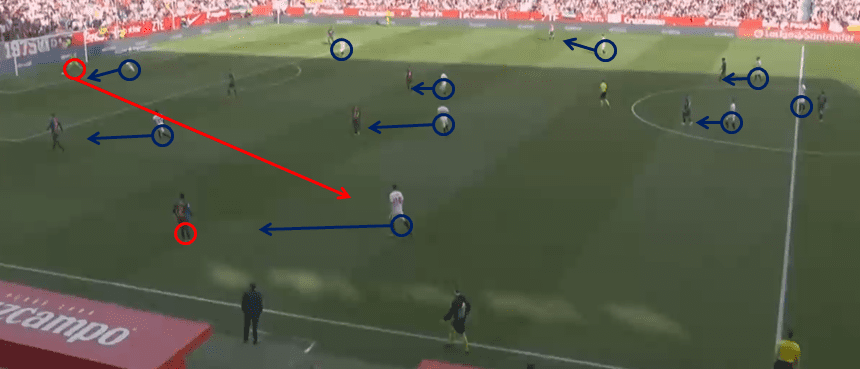
Sevilla covered his channels perfectly, winning their aerial duels whenever the German tried to distribute the balls. It was a relentless tactic of the home team that seemed to work brilliantly. Ter Stegen ended the game with a meagre 43% success in long balls and only three real ball distributions. Usually, he averages almost double those figures with 63.1% long ball success rate and 5.84 ball distributions.
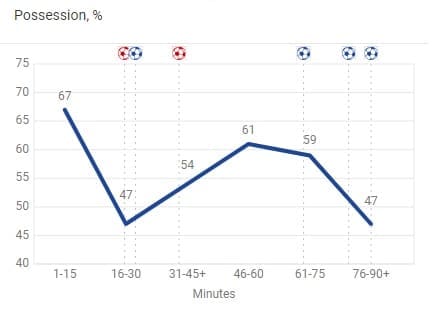
The only downside to this great Andalusian plan was that it left them with barely anything in their tank after they were done. If the game is not already in the bag, you might suffer afterwards.
And suffer they did.
The game of two halves
Ernesto Valverde couldn’t wait for too long without making some crucial changes since he was already 2-1 down at the beginning of the second half. Sergi Roberto was introduced instead of Nelson Semedo, and Arturo Vidal made way for the flashy Ousmane Dembele. This was done with the intention to make Barcelona’s attacks just a little bit sharper but it also redefined their shape.
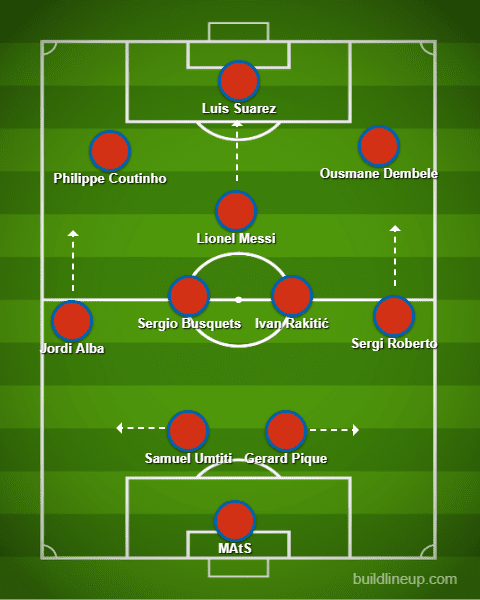
Swapping a midfielder for a forward meant that Ivan Rakitić shifted back to the right side of the pitch and formed a double-pivot with Sergio Busquets. Philippe Coutinho and Ousmane Dembele were now the wingers on the left and the right respectively, while Lionel Messi occupied the position behind the striker, with more freedom and more space to express himself.
This formation change made two things happen on the pitch: it gave Barcelona some much-needed width in the form of Dembele, and stretched Sevilla’s narrow shape to create pockets of space for the ever-attacking Catalan side.

In the first half, Barcelona had troubles playing to their own strengths. They struggled when building from the back, and couldn’t let their full-backs overlap as much as they would’ve liked. Sevilla kept Alba busy in a defensive aspect so that limited him going forward, and Semedo was instructed to stay deeper to begin with.
Now, with the formation and the mentality change, Barcelona looked like themselves once again. The hosts were drained because of a hectic first half so they couldn’t press or attack with the same intensity, which freed Alba on the left. The introduction of Roberto and Dembele made the right side dangerous once again with a lot of overlaps between the two players.
Lionel Messi was the obvious victor of this second half novelty from Valverde as the Argentine had a lot of newfound space to operate in. Notice below how Dembele stretches the back line, and Rakitić, who with the absence of Arturo Vidal is now the most advanced midfielder on the Blaugrana side, drags the marker away, leaving Messi all alone.
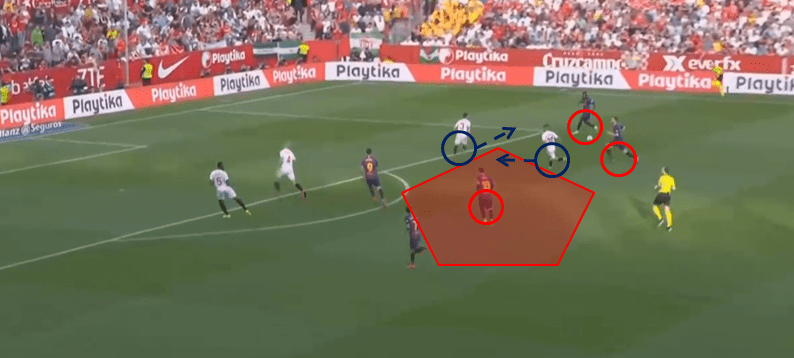
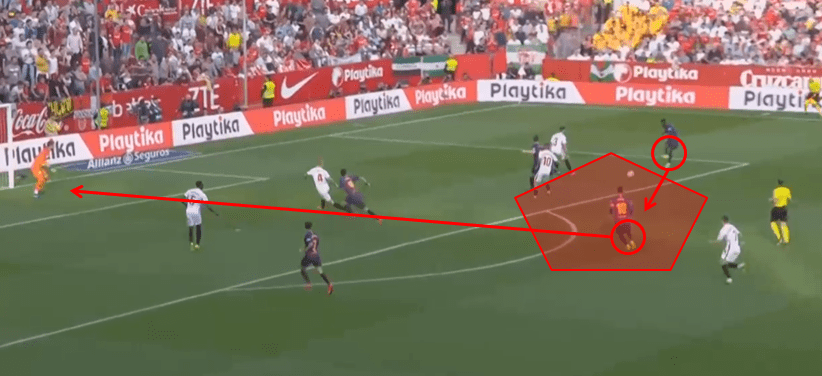
Interestingly enough, once they found their presence and their flow again, Barcelona switched back to the 4-3-3 later on in the game. In those moments, Sevilla looked a bit revitalised but still not as much in the game as they had been in the first half.
This went on until around the 80th minute when Carles Alena was introduced as Barcelona’s final sub and attempt to swing the game entirely in their favour. It’s safe to say it worked beautifully. The young La Masia gem replaced a lacklustre Philippe Coutinho and made an instant impact on the pitch.
Alena was involved in both the goal to secure the lead and the one to finally secure the win, putting his name even more to the forefront of Valverde’s mind. Both Coutinho and Vidal are slowly falling behind the young midfielder, and it should soon translate into palpable minutes.
Conclusion
It was an extremely fun game to watch, and a real thriller for the eyes, as is expected every time these two strong teams meet. Sevilla managed to dominate proceedings in the first half due to a few clear advantages.
For starters, Barcelona’s team selection left them in a bad spot with no width and susceptible to Sevilla’s compact shape which soaked up any attempts on goal. Barcelona’s counter-press was non-existent due to slow transition play and a lack of players putting in the defensive work consistently enough. This made them vulnerable to fast breaks from the other side.
Sevilla’s 5-4-1 defensive shape when welcoming Barcelona emphasised their numerical superiority and making ball progression much more difficult. Finally, there were a lot of individual mistakes in Barcelona’s lines, especially in giving the ball away (104 times) and bad positioning.
Samuel Umtiti made his return after a long injury but it proved to be a tough comeback game for the Frenchman, leaving him somewhat at fault for the two goals conceded. Still, things are always easier when you have Lionel Messi in your ranks. The little Argentine wizard scored his 50th career hattrick and ramped up his goals tally to 650: insane figures, even for his high standards.
Sevilla came prepared, that much was visible, but they couldn’t sustain their high-intensity gameplan throughout the whole 90 minutes. At the end of the day, their coach, Pablo Machin, summarised it best:
“My coaching staff and I have been planning the whole week, since Monday, how to stop Messi. Yet he ended up with three goals and one assist. I realise no one in the world can stop him. He’s the greatest in history, no doubt.”
The xG stat would agree with Sevilla’s man: 1.52 for the home team, and 1.31 for the visitors. Purely looking at those, you would think Sevilla managed to salvage some points, but we often forget that ordinary (and extraordinary) laws of football apparently don’t apply to extraterrestrials.
Who would’ve thought, huh?
________________________________________________________________________
If you love tactical analysis, then you’ll love the digital magazines from totalfootballanalysis.com – a guaranteed 100+ pages of pure tactical analysis covering topics from the Premier League, Serie A, La Liga, Bundesliga and many, many more. Buy your copy of the February issue for just ₤4.99 here, or even better sign up for a ₤50 annual membership (12 monthly issues plus the annual review) right here.

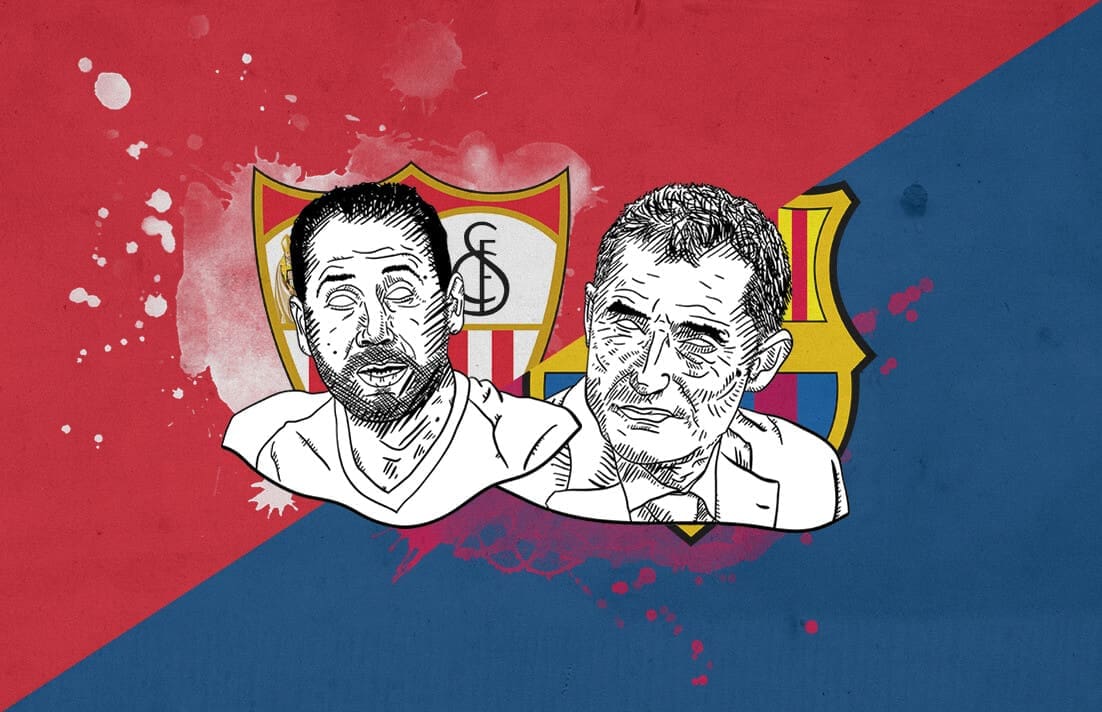




Comments